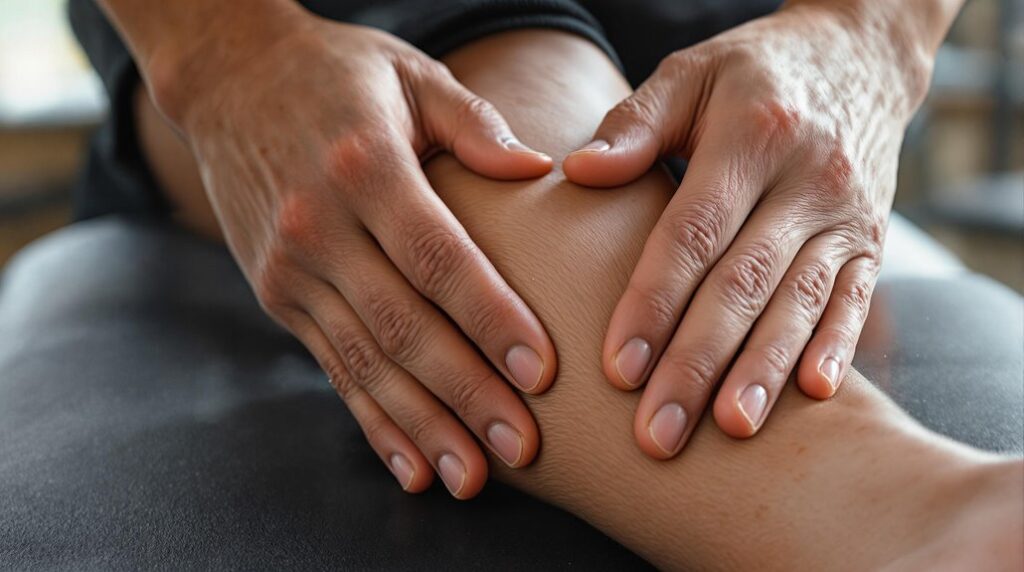You'll maximize your myofascial release benefits by following five key strategies: foam roll major muscle groups slowly for 30-60 seconds, schedule longer sessions before bedtime and shorter ones pre-workout, use tennis balls for hard-to-reach areas like glutes and shoulders, select appropriate tools based on your training intensity, and maintain consistent post-exercise release protocols focusing on large muscle groups first. Understanding these fundamental techniques opens the door to enhanced athletic performance and recovery.
Proper Foam Rolling Techniques for Major Muscle Groups
A foam roller serves as an indispensable tool for athletes seeking to maintain muscle health and enhance performance. When rolling major muscle groups, you'll want to move slowly and deliberately, spending 30-60 seconds on each area. Start with your calves by placing the roller under your lower leg, then progress to your quadriceps, hamstrings, and IT band while maintaining steady pressure throughout.
For best results, you should roll each muscle group in multiple directions, focusing on tender spots known as trigger points. Don't rush through the process; instead, pause when you find areas of tension and hold that position until you feel the muscle begin to release. If you're experiencing intense discomfort, reduce the pressure by supporting more of your body weight with your arms or opposite leg. Additionally, foam rolling can help improve circulation, which is essential for effective recovery and enhanced performance.
Timing Your Myofascial Release Sessions
While proper technique matters greatly, the timing of your myofascial release sessions can considerably impact their effectiveness. You'll want to schedule longer sessions of 15-20 minutes before bedtime to promote recovery and relaxation, while shorter 5-10 minute sessions work best immediately before workouts to enhance mobility.
For best results, you'll need to perform myofascial release at least 3-4 times per week, focusing on post-workout recovery when your muscles are warm. If you're dealing with specific problem areas, you can target these spots twice daily, but don't exceed this frequency as overworking the tissue can lead to increased sensitivity. On rest days, you'll benefit most from performing your release work in the morning to reduce stiffness and improve blood flow throughout the day. Additionally, incorporating sports massage into your routine can further support athletic performance and expedite recovery.
Using Tennis Balls for Hard-to-Reach Areas
Tennis balls serve as effective tools for targeting hard-to-reach muscle groups, particularly in the upper back, glutes, and shoulders where foam rollers can't easily access. You'll find they're especially useful for pinpointing trigger points and releasing tension in smaller, concentrated areas.
To use a tennis ball effectively, you'll want to position it between your body and a wall or floor, then apply gradual pressure while moving slowly across the targeted area. When you locate a particularly tender spot, pause and maintain pressure for 30-60 seconds until you feel the tension release. For areas like the upper back, you can place two tennis balls in a sock, creating a tool that mimics the width of your spine while protecting the sensitive vertebrae between the muscle groups.
Recovery Tools and Equipment Selection
Selecting effective recovery tools requires careful consideration of your specific athletic needs, training intensity, and target muscle groups. You'll find that foam rollers come in varying densities, from soft to extra-firm, while massage balls range from smooth lacrosse balls to textured therapy spheres.
For deeper tissue work, you'll want to invest in a massage stick or theracane, which can help you apply precise pressure to troublesome trigger points. If you're dealing with chronic muscle tension, consider a percussion massage gun, though they're typically more expensive than manual tools. When choosing between options, factor in portability, especially if you'll need to transport your tools to competitions or training facilities. Don't forget to evaluate the durability of materials, as high-quality tools will maintain their effectiveness longer and provide better value over time. Additionally, understanding specific injury recovery can guide you in selecting the most appropriate tools for your needs.
Post-Exercise Release Protocol
After completing your workout, it is crucial to follow a systematic approach to myofascial release that maximizes recovery benefits and prevents potential muscle adhesions. Begin with larger muscle groups before progressing to smaller ones, spending 30-90 seconds on each area while maintaining consistent pressure and breathing patterns.
- Roll the foam roller slowly across your quadriceps, feeling each segment of muscle tissue release beneath the pressure
- Apply targeted pressure to your IT bands using side-lying positions, pausing on sensitive spots
- Work through your calves with circular motions, focusing on both the lateral and medial aspects
You'll want to maintain a pressure level of 6-7 out of 10 on your personal discomfort scale, adjusting as needed to accommodate particularly sensitive areas. Complete your protocol within 10-15 minutes while your muscles are still warm. Incorporating soft tissue therapy techniques can further enhance your recovery process and improve overall muscle function.

